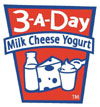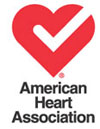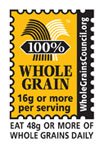Nutrition symbols: are they fact or
promo?
by Catherine Grych Dietetic Intern
For years, the health conscious consumer would flip over a package of food to see the nutrition information. Lately, with an increase in nutrition-friendly packaging, the consumer seldom has to search beyond the front panel for nutritional facts.
In fact, nutrition symbols are popping up on boxes, bags and cans. These symbols have been created by individual companies to guide consumers toward making healthier choices. Nutrition symbols may imply that a product is lower in calories, fat or sugar. It may also state a product meets federal requirements for a specific vitamin or mineral content. Meanwhile, the U.S. Food and Drug Administration is attempting to streamline nutrition labels to decrease confusion in the market. Ideally, one universal symbol would be created to rate a product based upon the specific criteria.
The March issue of the ADA Times, a monthly journal from the American Dietetic Association, features an article breaking down nutrition symbols and some of their implications. Here are a few of the many nutrition symbols and some information about them:
 National
Dairy Council: This symbol is placed on cheeses, milks and
yogurts that meet specific FDA guidelines. These foods can be
considered healthy choices towards your three recommended servings of
dairy a day. Visit http://www.nationaldairycouncil.org.
National
Dairy Council: This symbol is placed on cheeses, milks and
yogurts that meet specific FDA guidelines. These foods can be
considered healthy choices towards your three recommended servings of
dairy a day. Visit http://www.nationaldairycouncil.org. Unilever:
Unilever produces this symbol, as well as a similar “Drink
Smart” symbol. The symbol lets consumers know the product meets the
company’s specific criteria for trans fat, saturated fat, sodium,
sugar, and added sugar. For more information visit http://www.unileverusa.com.
Unilever:
Unilever produces this symbol, as well as a similar “Drink
Smart” symbol. The symbol lets consumers know the product meets the
company’s specific criteria for trans fat, saturated fat, sodium,
sugar, and added sugar. For more information visit http://www.unileverusa.com. American
Heart Association: Products boasting this symbol meet the
American Heart Associations criteria for total and saturated fats,
trans fat, cholesterol, sodium, vitamins A and C, iron, calcium,
protein, and dietary fiber. For information visit http://www.americanheart.org.
American
Heart Association: Products boasting this symbol meet the
American Heart Associations criteria for total and saturated fats,
trans fat, cholesterol, sodium, vitamins A and C, iron, calcium,
protein, and dietary fiber. For information visit http://www.americanheart.org.  Whole
Grain Council: The Whole Grain Council has two different stamps.
One stamp notes that a product has 8 grams or more of whole grain per
serving. The “100%” stamp states the product has at least 16 grams of
whole grain. For more information visit http://www.wholegrainscouncil.org.
Whole
Grain Council: The Whole Grain Council has two different stamps.
One stamp notes that a product has 8 grams or more of whole grain per
serving. The “100%” stamp states the product has at least 16 grams of
whole grain. For more information visit http://www.wholegrainscouncil.org. PepsiCo:
The Smart Spot indicates that the product exceeds 10 percent of the
daily value of a targeted nutrient, and meets limits for fats,
cholesterol, sodium and added sugars. Visit http://www.smartspot.com.
PepsiCo:
The Smart Spot indicates that the product exceeds 10 percent of the
daily value of a targeted nutrient, and meets limits for fats,
cholesterol, sodium and added sugars. Visit http://www.smartspot.com. Kellogg’s:
This panel takes information from the nutrition facts panel and places
it in clear view. Calories, total fat, sodium and sugar are among the
components listed. General Mills also has a “Nutrition Highlights”
panel that provides similar information. Visit http://www.kelloggs.com.
Kellogg’s:
This panel takes information from the nutrition facts panel and places
it in clear view. Calories, total fat, sodium and sugar are among the
components listed. General Mills also has a “Nutrition Highlights”
panel that provides similar information. Visit http://www.kelloggs.com.Smaller stores and companies also are creating their own logos to place on the front of nutrition packaging. A benefit of these labels is that they help consumers identify products that can be considered better choices. However, the reason these items may be better than others is not always clear. Not every company lists the criteria they used to determine a product healthy, and not all provide their Web sites for more information.
Nutrition symbols point the consumer in the right direction of healthy choices, however, these choices may not be the best available.
Better consumer choices relies on the individual taking the initiative to flip the package, look at the nutrition facts label, and determine how that item fits into their diet.
Friday, April 25, 2008
Catalyst Online is published weekly,
updated
as needed and improved from time to time by the MUSC Office of Public
Relations
for the faculty, employees and students of the Medical University of
South
Carolina. Catalyst Online editor, Kim Draughn, can be reached at
792-4107
or by email, catalyst@musc.edu. Editorial copy can be submitted to
Catalyst
Online and to The Catalyst in print by fax, 792-6723, or by email to
catalyst@musc.edu. To place an ad in The Catalyst hardcopy, call Island
Publications at 849-1778, ext. 201.